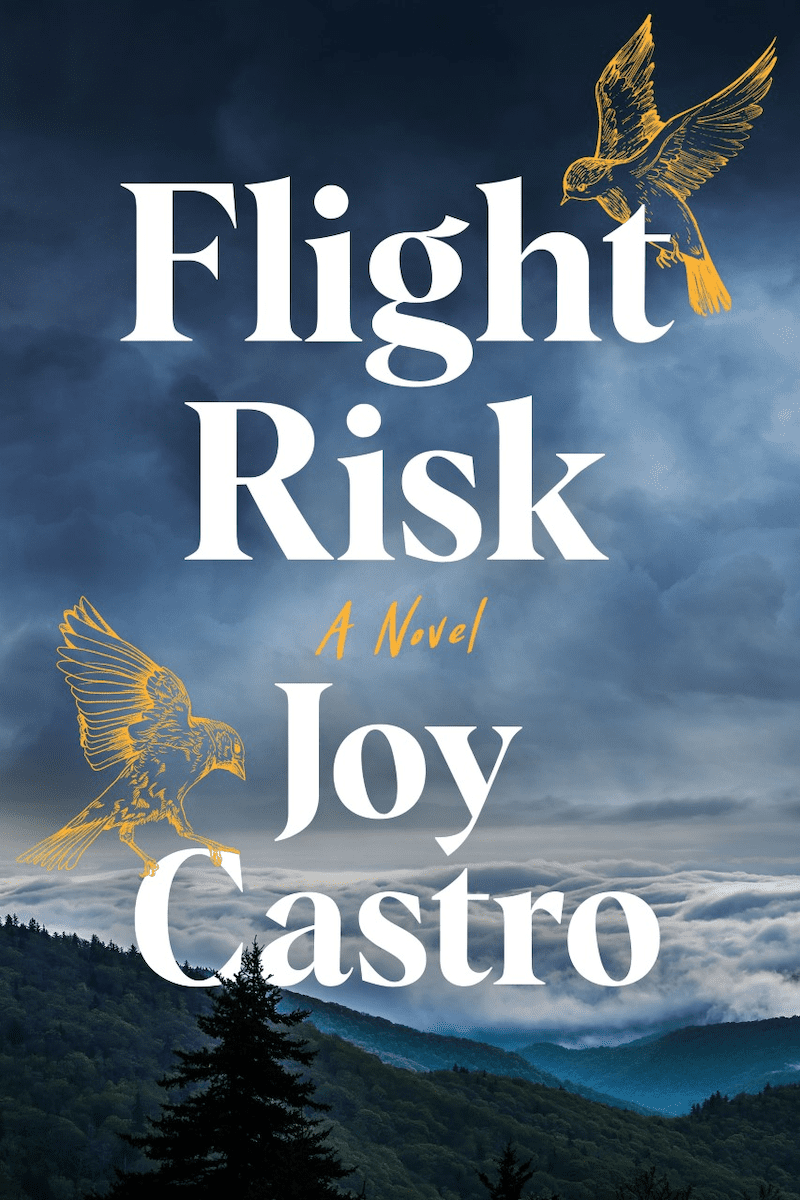We are thrilled to bring you this exclusive first look at the cover of Joy Castro’s new novel, Flight Risk, forthcoming from Lake Union Publishing on November 1, 2021.
Isabel Morales is a successful Chicago sculptor hiding a brutal family history―one not even her husband knows. After decades of turning her back on her past, she’s forced to return to Appalachia when she receives news of her estranged mother’s death.
But going back means revisiting the traumatic childhood she escaped―and the family that cast her out when she needed them most. Back on the land she has inherited, she’s flooded with memories of the forest where she once roamed free, of her beloved lost brother, and of the old house in the West Virginia hills where she grew up. Her mother has left her another legacy, too, which reveals secrets that Isabel is only beginning to understand.
As forces bear down and threaten to take what she has left, it’s time for Isabel to step into her power, reclaim her roots, and finally confront the painful memories that have kept her from the life she truly wants.
Below, Joy Castro shares her thoughts on Flight Risk’s cover. Then, illustrator, designer, and photographer Micaela Alcaino offers us a glimpse at how the cover came to be.
***
Joy Castro on the cover art for Flight Risk (Lake Union Publishing, 11/1/21):
“Almost heaven, West Virginia,” we sang along with the John Denver eight-track tape, winding north through the Smokies and then the Alleghenies in our mother’s white AMC Hornet hatchback. Up ahead, our father drove the yellow Ryder truck, leaving our history behind.
The Appalachians were a strange place for a Cuban American family from Miami to settle. “Wild, wonderful West Virginia,” beckoned the thick travel brochures our parents had shown us, with alluring photos of steep, wooded mountains so lush and verdant they verged on blue. In my seven-year-old mind, their deep green folds conjured fairy-tale visions of forests and enchanted woodland creatures straight from the Brothers Grimm—so different from the flat, hot streets of Kendall where I rode my bike to the U-Totem for milk and older kids threw rocks.
“Country roads, take me home / to the place I belong.” Full of hope, we sang along with my mother. What my little brother and I could not then know is that our family was heading north to reinvent itself. We were driving away from the signs in Miami Beach that said, No Cubans, no dogs; away from memories of the terror my father had suffered at the hands of white police; away from the string of girlfriends he’d used to shore himself up.
My mother still loved him; she was willing to try again. Driving north, my parents, too, sought a fairy tale.
It did not work. Our lives became only stranger, so far away from home. We lived in an old farmhouse on Nolan’s Run, a dirt road with a coal mine at the end. A quiet child, I found solace in books and in the woods, where I was free to roam alone for hours. The smell of moss. The sliding carpet of fallen pine needles. Deer. Rabbits. Skunks. My father paid twenty dollars for an untamed Shetland mare, and I rode her bareback through the forests, climbing trails, jumping creeks. My parents divorced. Each remarried. We slid into poverty. While our lives unraveled, I plunged into the forests that rose around our house. We moved, then moved again.
At fourteen, I ran away. At sixteen, I left for college in Texas. My brother followed; he lives in Texas still. The last time we saw West Virginia, we were attending the funeral of our father, dead by his own hand.
In writing the suspense novel Flight Risk, I wanted to explore the life of a Latina who—despite being a fish out of water, despite struggling with family violence and dysfunction—passionately loves the forest and its creatures, as I did. Like me, Isabel Morales is both an artist and a runaway, and Flight Risk describes her odyssey. Truly at home nowhere but in the forests of her native Appalachia, she nonetheless finds success in work and love in Chicago—but cannot trust her happiness there. She hides her past, hides herself. Instead of disclosing her troubling truth, Isabel works as a found-object sculptor, a bricoleur of life, pastiching unlike objects together to evoke a sense of eerie power.
I love the way the brilliant designer Micaela Alcaino chose a similar approach for the cover of Flight Risk, melding images from different genres to create a sense of mystery. The indeterminacy of the brooding sky—is it darkening, or growing lighter?—works with the tension in the novel, the way so little is what it initially seems. I love the startling delicacy of the gold overlays of birds, their bright saffron lines capturing the ethereal delicacy and intricacy of lace, suggesting the fragility of Isabel’s character and the tenuous nature of her marriage. When is it safe to build our nest? When should we take flight? I love the subtle way the larger bird’s talons grip the letter C, echoing the grip of Isabel’s controlling husband.
The birds hint, too, at the Brothers Grimm fairy tale “The Six Swans,” in which a young woman first carelessly dooms and then steadfastly rescues her brothers, navigating her loyalties to her family of origin along with her roles as a wife and mother. This tale provides the archetypal narrative architecture that scaffolds Flight Risk. I love “The Six Swans” because it is a tale of long, unbroken silence, which is what I kept for years, and because it moves beyond happily-ever-after to probe the complexities of marriage. The fairy tale also features a hostile, scheming mother-in-law and heart-wrenching fertility issues, which play a role in the novel.
In her bold, clear cover design, I admire the subtle way Micaela has made the text itself into an object that engages the visual field: the capital C, both gripped by the bird’s claws and obscured by the branches of an evergreen tree, links the two panes of imagery. In this recrafted version of reality, language is not separate from visual imagery, but intertwined with it, inextricable, integral. The essential, shaping force of language—legal language, lovers’ language—acts almost like a solid object in the world. The language with which we share our stories shapes the way we see.
Exploring artistic ambition, reproductive choices, and political responsibility in an era of climate crisis, Flight Risk asks the fundamental, haunting question: How can we love across difference?
Artist Micaela Alcaino on the cover design process:
Joy Castro’s book Flight Risk was an outstanding and captivating narrative that I had the privilege to read ahead of this project. The story’s emotive, dark, and poetic tonality became the inspiration for the design of the book’s cover, in which I wanted to capture the dichotomous tensions between freedom and the sense of being trapped.
I utilized the book’s literary display of flora, fauna, and the contextual landscape as a means to visually portray the stories’ themes. As the book explores the protagonist’s journey of revisiting her past as a means of dealing with her present life, I felt it was important to create a multilayered design with the use of both photography and illustration. The interaction of mixed media works to convey both the external and internal journey the main character embarks on.
The typeface Albra acted as the final element to draw the cover together. I found that the serif design with its subtle groves worked well to establish a modern and bold title to work in harmony alongside the visuals.
As with all my projects, collaboration is an important aspect of my process. Working alongside the team at Lake Union and with Castro, we were able to create a cover that held the integrity of the story that exists within.
***
Photograph of Joy Castro by Shae Sackman.





